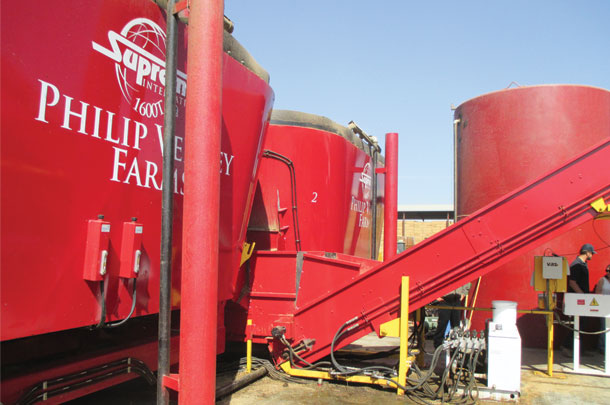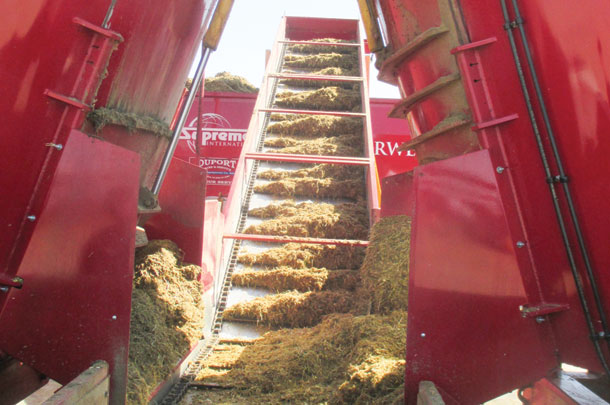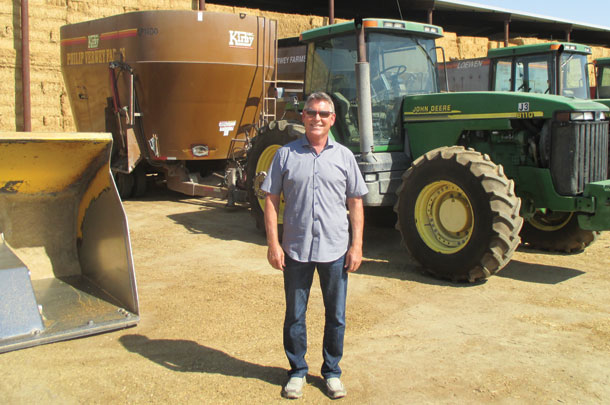A crowd of about 150 dairy operators, local dignitaries, air district officials and media gathered on Oct. 7 for an open house and tour of Verwey Farms near Hanford, California, to learn about its new electrified, stationary feed mixing operation.
The system replaces the farm’s polluting diesel-powered equipment with clean electric-powered equipment. The project uses two stationary mixers and clean-burning diesel trucks to deliver the mixed feed products.
The system is expected to reduce the farm’s nitrogen oxides by 22 tons annually, fine particulate matter by 2.2 tons annually, hydrocarbons by 1 ton and carbon dioxide by 648 tons, while saving more than 90,000 gallons of diesel fuel annually.
Verwey Farms, which has 10,000 cows, applied for a grant for the project from the San Joaquin Air Pollution Control District and received $300,000 to cover part of the system’s $1.1 million price tag. 
The total cost will be recouped in two-and-a-half years, according to Philip Verwey, the farm’s owner. He explained at the event that his farm has already been able to reduce its workforce and will also benefit from lower fuel costs and not having to replace the tractors used in its previous feed operation.
Supreme International, based in Alberta, Canada, built the stationary mixers, which are designed to cut material uniformly and to blend feed and additives together.
“The whole concept is: Your first cow eats what the last cow eats,” said Jeannette Guertin, company president.
Although a stationary mixer’s capacity continues to grow to accommodate the growth in the size of dairies, the technology itself has been around for years. The sudden interest in the technology is a result of the San Joaquin Air Pollution Control District’s Technology Advancement Program (TAP), which encourages “innovation and development of new emission radiation technologies” in California’s San Joaquin Valley.
“Despite major reductions in emissions, the valley continues to face difficult challenges in meeting federal air-quality standards,” said Seyed Sadredin, executive director of the air district. “It is virtually impossible for the valley to attain the new standards for ozone and particulates without these significant advancements in low-emission technologies offered through TAP projects.
“We face some of the toughest challenges in the nation because of God-given conditions in the San Joaquin Valley,” he said. “The valley is essentially a bowl, and its two main freeways bring in a lot of pollution.”
“The San Joaquin Valley offers many opportunities for testing advanced clean air technologies,” said Kerry Drake, air division associate director for the EPA’s Pacific Southwest region. “By continuing to work together to develop new technologies, such as these electrified dairy feed mixers, we can move toward our ultimate goal of bringing healthier air to valley residents.”
The project at Verwey Farms represents a new approach to cleaning up air in the San Joaquin Valley. 
“A lot of state money has gone to take away a dirty engine and replace it with a clean engine,” said Kevin Wing, air quality specialist for the air district. “This project is a process change rather than an equipment change. It is the first of its kind. We’re using this as kind of a pilot.”
Although the district approved the Verwey Farms’ grant, other farms would “probably not” be as successful with similar grant proposals, according to Wing, who suggested that there might instead be other new financial incentives for valley farmers. He explained that the district is closely monitoring the results at Verwey Farms to help it determine “an appropriate incentive level to have it make sense” to both the air district and farms in the valley.
“There will be a report at the end of the process,” said Wing. “It’ll be in about a year. We want to collect a year’s worth of data. We want to see if there are changes with the seasons.”
Meanwhile, Verwey Farms is already reporting on the results of the new system. 
“We’re reducing man-hours by close to 50 percent,” said Frank Cardoza, dairy manager at Verwey Farms. “We’ve gone from six employees to four, but the man-hours we’re running is closer to half.”
But the new system is about more than saving money, according to Cardoza.
“It paces your employees,” he said. “When we’ve got it running, it sets the pace. It’s the flow. You’re better off with three people and being more efficient – and people enjoying their jobs.”
“We feed our cattle in half the time,” added Verwey.
Verwey Farms has plans to install a methane digester to use cow waste to power the system. “That’s pretty darn efficient,” said Cardoza. “By the middle of next year, we’re going to be self-sustaining.”
Verwey is considering installing the system at two other valley locations: a dairy in Madera and a feedlot in Firebaugh. PD
Steve Pastis is a freelance writer based in Visalia, California.
PHOTO 1: Feed material is added to Verwey Farms’ stationary mixers.
PHOTO 2: New electric-powered stationary mixers supply dairy feed to a conveyor.
PHOTO 3: The system’s conveyor takes the feed from the stationary mixers to fill the farm’s delivery box.
PHOTO 4: Philip Verwey stands in front of tractors now retired by his farm’s stationary mixers. All photos by Steve Pastis.




